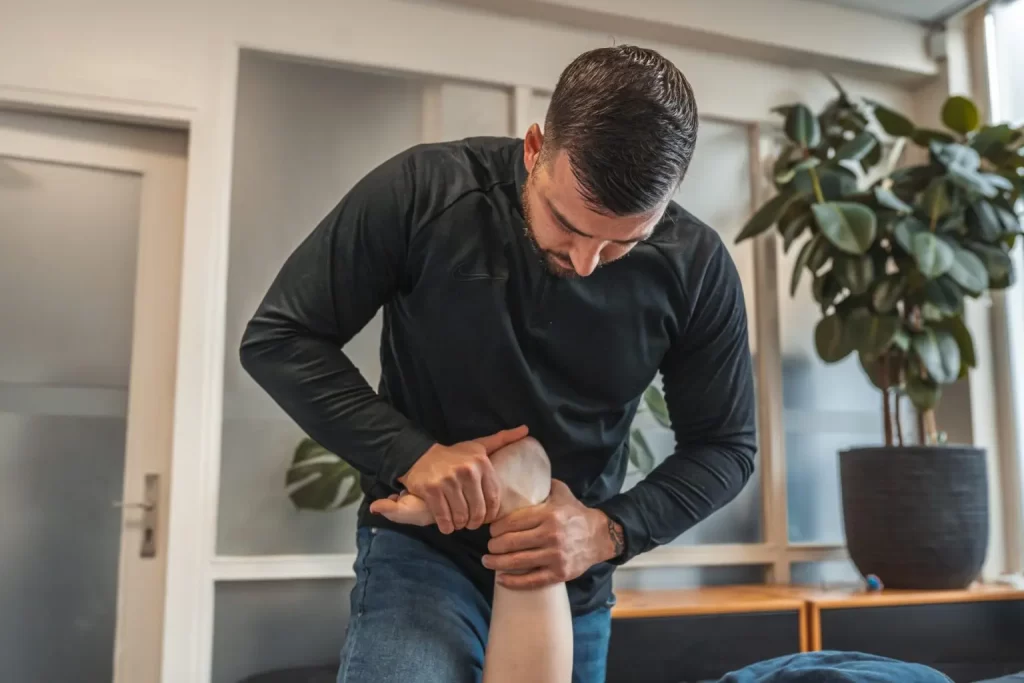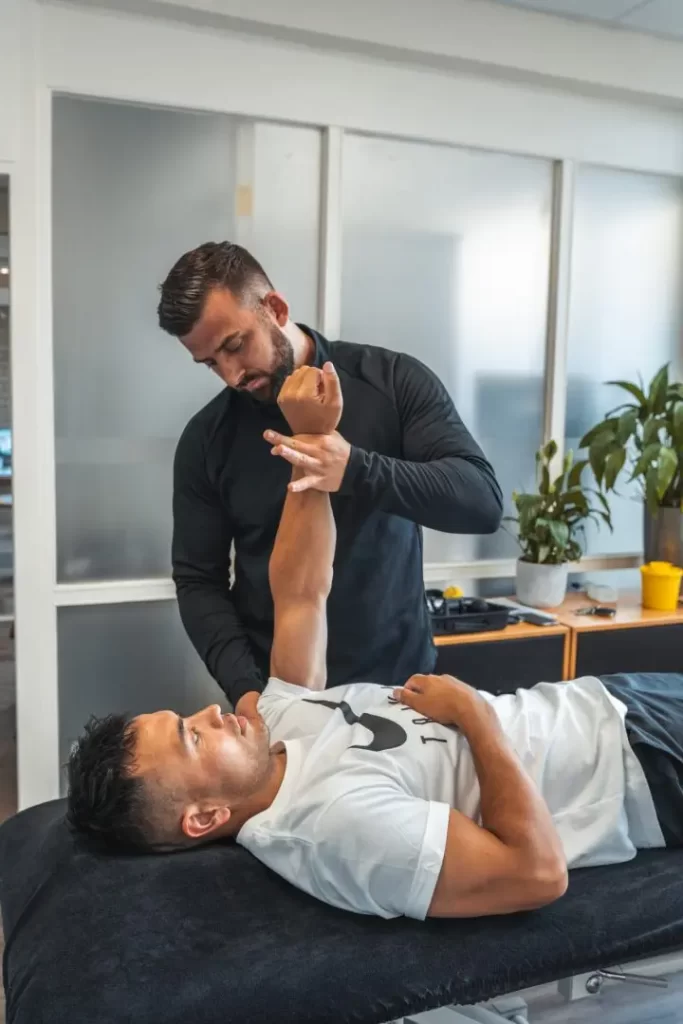Achilles tendinopathy
The lower leg consists of two bone pieces, namely the tibia (tibia) and fibula (fibula). On the underside (near the ankle), we find consisting of several bone pieces then the lower ankle joint and the upper ankle joint. In the lower ankle joint, movements such as inversion and eversion take place. In the upper ankle joint, plantar flexion and dorsal flexion/extension take place. The musculature at the back of the thigh is popularly called the calf muscles. This is a muscle group consisting of the soleus muscle and the larger, overlying gastrocnemius muscle with a lateral and medial head. The m. gastrocnemius is bi-articular. This means that the muscle crosses two joints and therefore performs a function in two joints. Both the soleus muscle and the gastrocnemius muscle run over the upper ankle joint and are therefore mainly responsible for the plantarflexion movement (standing on the toes). The difference is that the gastrocnemius muscle flexes the knee because it also crosses the knee. Ultimately, these muscles flow into the Achilles tendon and attach to a piece of bone called the tuber calcanei.
Like everywhere else in the body, something can go wrong with the calf muscles/achilles tendon. Here, we actually distinguish two possible problem areas. A muscle (or tendon) can become overloaded or a (partial) rupture can occur. Both problems have different origins and a different pattern of symptoms. So making a distinction is basically fine with the physiotherapist.

Cause Achilles tendinopathy
Achilles tendinopathy involves overuse of the tendon. This overuse usually occurs in the middle of the tendon or at the insertion. These are therefore the places where recognisable pain is often indicated. During any movement that requires these muscles to be active, forces are transferred to the tendons and the insertions on the bones. If this happens too often in a certain time frame, it can lead to irritation. Often, Achilles tendinopathy is a symptom where people develop symptoms over time. This is therefore because the tendon does not get enough rest after strain to recover properly. Hairline tears develop in the tendon and, as the body's attempt to keep the tissue in order, tendon tissue of poorer quality develops (tendinosis). These changes in tendon structure occur if the symptom is present for a longer period of time and would be visible on imaging studies. From the outside, you are not going to be able to feel or locate such changes.
Risk factors
The most well-known risk factor for developing Achilles tendinopathy is repeating the same movement frequently. Think especially of activities such as running. In addition, history related to tendinopathies can be a predictor for the development of an Achilles tendinopathy and increasing exercise load can be a risk factor. Furthermore, calf muscle weakness and inward slumping of the foot during walking are known to increase the risk of developing tendon overload. Furthermore, Achilles tendinopathy complaints have been found to be more common in winter than in summer. Research groups indicate that this seems to be related to the cold outside temperature during the winter period. So it is important to dress appropriately!
Complaints and symptoms
The symptom pattern in Achilles tendinopathy consists of a confluence of several factors. Thus, we often see people playing sports that demand a lot from the tendon, such as running. Further fitting the symptom picture is;
- Pain 2-7 centimetres above the insertion of the tendon.
- Complaints that develop slowly and increase over time.
- Sometimes localised thickening/swelling is visible.
- Often first complaints after activity and when starting after rest, later sometimes at rest.
- Demanding strength or just stretching the tendon can give recognisable pain.

Diagnosis and examination
Often the diagnosis of Achilles tendinopathy is already clear following all the information from the intake interview. The therapist can use palpation to determine which part of the tendon is involved in the complaint. Further tests such as a stretch test and strength test can be performed, but have little further added value in making the diagnosis. It would then be more about determining whether it is possible to perform these movements.
Treatments and prognosis
The expectation in recovery from an Achilles tendinopathy is basically good. It is just hard to say how long recovery takes because it varies enormously from one individual to another. A large proportion of people experience a significant decrease in symptoms within 3 months. This combined with proper handling of the symptoms and the right guidance. Unfortunately, there is also a fairly large proportion of people where recovery can take up to 1 year or even longer. Do not be alarmed, as this does not necessarily mean that you will experience a lot of discomfort throughout this period and will not be able to carry out your daily (sports) activities. Because recovery from Achilles tendinopathy can generally take a long time, it is important not to let it distract you from your goal. Make sure that, even if things are not going as well for a while, you still stay on track. Also, recovery will not be a straight line upwards. This goes with ups and downs. Keep in mind that if you feel a little more again you won't have relapsed right away, but make sure you deal with it in the right way even then.
When you come to the physiotherapist and the tendon problem has been diagnosed, you naturally start treating the complaint. The first step in the process is to provide the right information and advice. Important for recovery is that you start making (temporary) adjustments in your daily use of the tendon. So determine whether the sports and activities you are currently doing are appropriate for your recovery process. If they are not, you will have to rearrange them or sometimes drop activities temporarily.This will give the tendon more time to rest. For how long this advice applies depends on the course we are going to see over time. Assume in advance that it is going to be a process of months, then it might just be better than expected.
In the further treatment process, the physiotherapist has several methods/techniques to help shape the treatment. The following treatment methods are best known for Achilles tendinopathy:
Massage/friction
There is some evidence in the literature about positive effects related to deep tissue massage in Achilles tendinopathy. However, the advice is to apply it in combination with an active exercise policy.
Exercise therapy
Literature advocates the use of exercise therapy in tendon complaints such as Achilles tendinopathy. In particular, eccentric loading of tendon tissue (loading while lengthening the muscle) seems to be able to provide the right stimulation to reduce symptoms over time. The idea is that the controlled high tension on the tendon will stimulate it to start producing strong new fibres. Besides taxing exercises, stretching the muscle is also used within the realm of exercise therapy. Keeping the muscle/tendon in a stretched position for an extended period of time could produce pain-relieving effects. It is important that exercise therapy is applied with proper regularity and also sufficient rest to recover from the given strain.
Heel elevation/tape/dry needling/shockwave
Using a heel lift has no scientifically proven effect. In practice, patients' experiences are mixed. Some say they noticed a difference when using a heel lift, others did not. The question is whether, if a difference was noticeable, this was based on the use of a heel lift. Based on insufficient scientific evidence, we cannot directly recommend its use to date.
Kinesio tape has greatly gained in popularity in recent years for a diversity of physical complaints. For the treatment of Achilles tendinopathy, studies describe no positive effect. On this basis, the use of this treatment method for these complaints is also not recommended. We can say the same about dry needling, shockwave and other forms of therapy. None of these will be successful if the complaints are dealt with adequately in combination with an appropriate exercise programme.
Medicated
Pain-relieving medication may be part of the treatment. This is especially advisable for people who experience a lot of pain. It should be noted, however, that the aim is of course to comply with the advice given. Depending on the symptoms and the severity of pain, a choice of medication can be made. Never take this lightly. Your GP is the best person to consult when it comes to medication. So always consult them before starting medication.
Putting a corticosteroid injection is not recommended for an Achilles tendon injury.However, other types of injections can be used at the time when through exercise therapy, adjusting load and proper adherence to living rules, insufficient results are achieved over time. An injection is not preferred as it does not benefit the quality of the tendon tissue. However, if natural recovery will not succeed, it is sometimes the best option.
Conclusion
Various treatment methods are known for the treatment of Achilles tendon pain. The literature always recommends a foundation of load adjustment combined with an adequate exercise programme for at least 12 weeks. Furthermore, there are several treatment methods that can be used in combination with this basis. Mainly, these are advised to be used if insufficient results are achieved over time. The role of the physiotherapist lies in advising and guiding this course. Perhaps the biggest challenge lies in that the injury can require considerable patience.
Well, there are no short-cuts when it comes to tissue repair. Above all, be patient and make sure you deal with your symptoms as well as you can. Then you will have the best recovery over time.
Making an appointment at FysioFitaal
We work from multiple locations in Tilburg, always close by for professional and accessible physiotherapy. Fill in the contact form and we will contact you soon. Together, we will work on your recovery!

